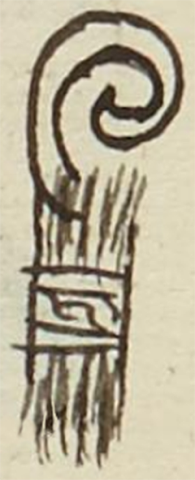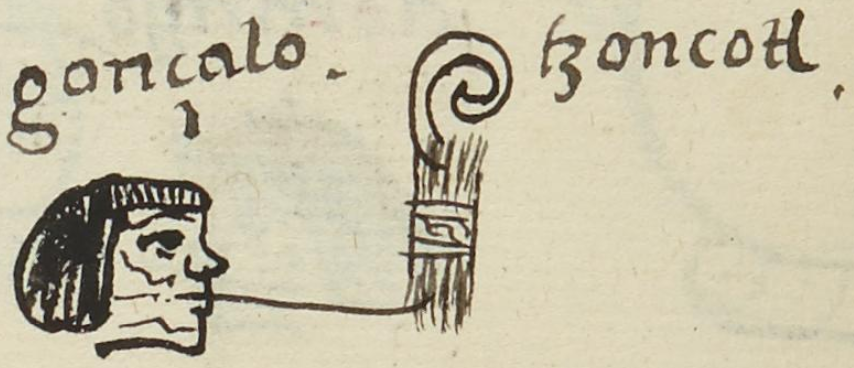Tzocotl (MH676v)
This black-line drawing of the compound glyph for the personal name Tzocotl ("A Little Bit") is attested here as a man’s name. The glyph shows a bound bundle (perhaps of grasses) that represents 400 (tzontli). Above the bundle is a curling shape (undeciphered, but something like colli). It would seem that these two elements are both phonetic indicators for the term tzocotl, with -col being a near homophone for -cotl.
Stephanie Wood
Four hundred, of course, is a vigesimal quantity, and the Nahuas had a vigesimal (root of 20) numerical system. A gloss on another example of tzontli (a case of 10 tzontli, or 4,000) refers to the items as "ramitos" (little branches). Likewise, a century ago, 400 small pieces of firewood were bundled in what was called a tzontle, a Nahuatl loan in Spanish. (See: Paul Carpenter Standley, Trees and Shrubs of Mexico - Part 1, 1926, 806.) This may support the reading that this numeration called a tzontli could have a visual association with branches or trees. Some signs for tzontli do look like the laurel or pine branches (acxoyatl) that were part of religious rituals. Nigel Davies (Human Sacrifice, 1981, 218), in fact, called a tzontli sign a "fir tree." Zelia Nuttall (in a volume of anthropological papers called Boas Anniversary Volume, published by Berthold Laufer in 1906, 296) refers to the bundles of 400 as containing either "sticks" or "hair." Some of the tzontli glyphs across this collection, such as the example here, do look like upright bundles of sticks that are bound around the middle. A binding like the one on this glyph above also appears in the Matrícula de Huexotzinco in a glyph for Tzompan, below.
Another common visual associated with the word tzontli involves large locks of hair or even strings of hair from the head. "Hair" is often the translation for tzontli into English. This word for hair and the word for 400 would therefore serve as homonyms. Similarly, speaking of 400 tzontles, four hundred corn cobs (Calixta Guiteras Holmes, Perils of the Soul, 1961, 47), is another case where the tzontli is simply a numeration and does not reflect upon the object being counted. So, the conclusion is that a sign for 400, like all of them, whether branches, sticks, or hair, will have the role of a phonogram.
Stephanie Wood
gonçalo. tzoncotl
Gonzalo Tzocotl
Stephanie Wood
1560
Jeff Haskett-Wood
cuatrocientos, números, zacate, palos, crespo, rizo, bucle, nombres de hombres

tzon(tli), hair or four hundred, https://nahuatl.wired-humanities.org/content/tzontli
tzoco, a little bit, https://nahuatl.wired-humanities.org/content/tzoco
tzocotzin, a small thing, a bit, https://nahuatl.wired-humanities.org/content/tzocotzin
Matrícula de Huexotzinco, folio 676v, World Digital Library, https://www.loc.gov/resource/gdcwdl.wdl_15282/?sp=433&st=image.
This manuscript is hosted by the Library of Congress and the World Digital Library; used here with the Creative Commons, “Attribution-NonCommercial-ShareAlike 3.0 License” (CC-BY-NC-SAq 3.0).


